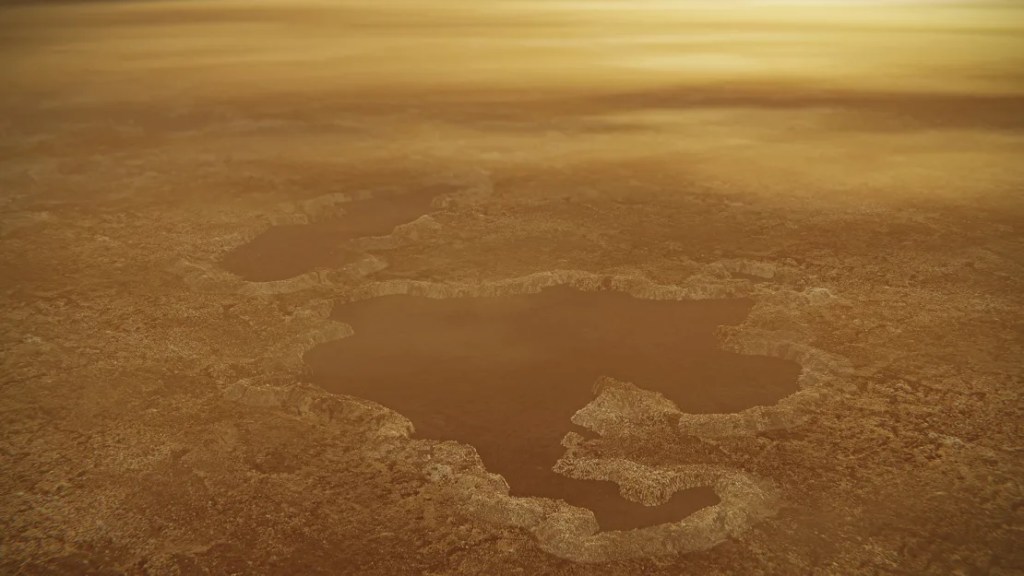“Magic islands”, which could be accumulations of organic matter, are disappearing on Saturn’s moon Titan.

(CNN) — Vanishing “fairy islands” on Titan, Saturn’s largest moon, have intrigued scientists since NASA’s Cassini mission discovered them during a flyby a decade ago. Now researchers believe they have unraveled the mystery of this phenomenon.
Originally thought to be bubbles of effervescent gas, astronomers now believe they could be honeycomb glaciers formed by organic material falling onto the lunar surface.
Scientists consider Titan one of the most interesting moons in our solar system because it shares some similarities with Earth. However, in many ways it also presents a bewildering alien landscape.
Larger than our Moon and the planet Mercury, Titan is the only moon in our Solar System with a thick atmosphere. The atmosphere is mostly nitrogen with some methane, giving Titan its fuzzy orange appearance. According to NASA, Titan’s atmospheric pressure is about 60% higher than Earth’s, so it exerts the same pressure that humans experience when swimming about 50 feet (15 meters) below the ocean’s surface.
Titan is also the only other world in our solar system that has liquid bodies on its surface like Earth’s, but the rivers, lakes and seas are made of liquid ethane and methane, which form clouds and cause liquid gas to rain from the sky. Cute.
The Cassini mission’s Huygens orbiter, which landed on Titan in 2005, made more than 100 flybys of Titan between 2004 and 2017 to reveal much of what scientists know about the Moon today.
Among Titan’s most mysterious features are its magical islands, which scientists observe as moving bright spots on Titan’s sea surface that can last for a few hours, a few weeks, or longer. Cassini’s radar images captured unexplained bright areas in Ligeia Mara, the second largest liquid body on Titan’s surface. The sea is 50% larger than Lake Superior and consists of liquid methane, ethane and nitrogen.
Astronomers believed that these areas could represent clustered bubbles of nitrogen gas, actual islands made up of floating solids, or objects attributed to waves (even though the waves only reach a few millimeters in height).

The artist’s illustration shows a lake at the north pole of Saturn’s moon Titan, including the raised edges observed by Cassini.
Planetary scientist Xinting Yu, an assistant professor at the University of Texas at San Antonio, focused on analyzing connections between Titan’s atmosphere, liquid bodies, and solid materials falling as snow to see if they could be connected to the magical islands.
“I wanted to find out whether fairy islands might actually be organic matter floating on the surface, like pumice that can float in water here on Earth before eventually sinking,” said Yu, the study’s lead author. published January 4 in the journal Geophysical. Research letters.
Scientists are eager to learn as much as possible about Titan before sending a specific mission to the Moon. The Dragonfly mission, led by the Johns Hopkins Applied Physics Laboratory in collaboration with NASA, is scheduled to launch in 2028 and reach Titan in the 2030s.
Analysis of the unusual world
In Titan’s upper atmosphere there are many organic molecules such as nitriles, hydrocarbons and benzene. Surface temperatures are so low (-179 degrees Celsius) that rivers and lakes formed from liquid methane, just as rocks and lava helped form landforms and channels on Earth.
Organic molecules in Titan’s atmosphere clump together and then freeze and fall to the surface of the Moon. Dark plains and dunes of organic material have been observed on Titan, and scientists believe these features were largely created by Titan’s “snow.”
But what happens when hydrocarbon snow falls on the strangely smooth surface of Titan’s lakes and rivers of liquid gas? Yu and his colleagues explored various possible scenarios.
Yu’s team determined that solid organic material falling from the upper atmosphere would not dissolve into Titan’s liquid bodies upon landing because they were already saturated with organic particles.

Infrared images taken by the Cassini spacecraft provide the clearest view of Titan yet from beneath the thick haze.
“For us to see the magical islands, they don’t have to just float for a second and then sink,” Yu said. “They have to float for a while, but not forever.”
But liquid ethane and methane have low surface tension, which means it’s harder for solids to float on them.
Yu’s team ran various simulations and determined that frozen solid material will not float unless it is porous, such as honeycomb or Swiss cheese. Small particles are also unlikely to float on their own unless they are large enough.
The team’s analysis led to a scenario in which frozen solid hydrocarbons accumulate near the coast, then break off and float on the surface, like glaciers on Earth. Liquid methane slowly seeps into frozen cumulus clouds, eventually causing them to disappear from view.
Additionally, a possible thin layer of frozen solids in Titan’s seas and lakes could explain why the Moon’s liquid bodies are so smooth, according to the researchers.
Approaching Titan
Over the next decade, Dragonfly is expected to explore plains of organic material in Titan’s equatorial region rather than its liquid bodies.
The landing helicopter will sample materials from Titan’s surface, study the potential habitability of its unique environment and determine what chemical processes occur on the Moon.
Titan also contains organic chemicals essential for life on Earth, such as nitrogen, oxygen and other carbon-based molecules. Beneath Titan’s thick crust of ice lies an internal ocean of salty water, not unlike the other amazing ocean world moons orbiting Saturn, such as Enceladus or Jupiter’s moon Europa, which some consider one of the best places to look for life. outside the Earth.
According to NASA, Titan sounds inhospitable, but it is possible that conditions there are conducive to life based on a variety of chemical processes and forms that are beyond our current understanding.